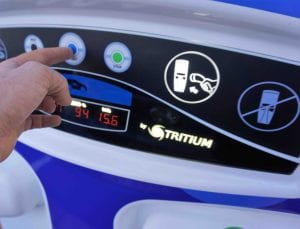The share of solar power in South Australia’s electricity grid reached a new record high on Sunday, suppling up to 93.7 per cent of state demand and more than 70 per cent of total production.
The new milestone was reached at noon and the solar share was largely driven by the state’s rapidly growing rooftop solar resource, which accounted for 900MW at the time, or 70.4 per cent of local demand.
The influence of rooftop solar also meant that the state also set a new minimum low for scheduled demand (the part of demand that comes from large generators on the grid) to just 315MW, according to Paul McArdle at Watt Clarity. This occurred about 10 minutes before the solar peak.
However, on the more conventional “operational demand”, which includes smaller semi-scheduled wind and solar plants, the minimum fell to 367MW about an hour later, also a record low for the state.
Around that time, the state’s large scale and rooftop generators were producing just over 1,700MW, but around one quarter of that was being exported to Victoria – which also had relatively low demand. The surplus of supply over demand meant that prices in South Australia were negative, and only around 293MW of gas generation was being used, and wind output was also being squeezed out by rooftop solar.
The rise of rooftop solar and its growing share of generation is forcing the state government to scramble to introduce new standards for inverters, and to introduce new protocols that can introduce dynamic controls on rooftop solar exports, and even disconnect large quantities of rooftop solar if needed.
The state government also announced to Sunday it was looking to introduce an Electric Vehicle Action Plan that would use EVs as mobile batteries and encourage daytime charging that could act as a “solar sponge”, mopping up excess solar production. The EV batteries could then be used to provide power to homes, or services to the grid, in the evening.
(See the story on our EV-focused sister site The Driven).
The South Australia state government wants to exercise more control over rooftop solar, now it is its biggest generation source during the day, and encourage demand to shift to daytime hours. This means more storate, demand management, and potentially the use of EVs.
Wholesale electricity prices were trading in negative territory for much of the day in South Australia, meaning that some solar and wind facilities switched off to avoid having to pay to produce. The state is usually able to export more capacity to Victoria, but there are currently limits on the main transmission link due to network equipment failures, and in any case demand and prices were low in Victoria.
Over the past week, the share of wind and solar in South Australia’s main grid has been high, accounting for more than 100 per cent of state demand on occasions, and 79 per cent of total production. That brought the average price for the week to just $4.37 a megawatt hour.
The state must run some gas generators to provide “synchronous power”, but that amount may reduce over the next 12-18 months as machines known as synchronous condensers (which do not burn fuel) are installed to provide that service.
McArdle from Watt Clarity said that when measured on the basis of ‘Scheduled Demand’ the 315MW minimum reached on Sunday appears to be, on quick scan, the lowest point experienced in the 22 years since the start of the NEM. Read more to find out the nuances between scheduled demand, operational demand and grid demand.











